WHAT IS DEAF-BLINDNESS?
Deaf-blindness refers to instances in which an individual has concomitant hearing and visual impairments. Roughly 45,000 – 50,000 American individuals are said to experience the effects of deaf-blindness today.
It is important to acknowledge that the term “deaf-blind” does not insinuate that an individual has both profound hearing loss and a severe visual impairment; instead, deaf-blindness possesses a spectrum in which an individual typically has more profound impairments in either vision or hearing.
In fact, out of all of the individuals with deaf-blindness today, only 1% of this population experiences both total blindness and profound hearing loss whereas 5% of individuals with deaf-blindness are totally blind and 20% have profound hearing loss.
Because of the fact that individuals with deaf-blindness experience at least some degree of hearing and vision impairments, opportunities for learning and communicating are often much more limited.
POTENTIAL CAUSES OF DEAF-BLINDNESS

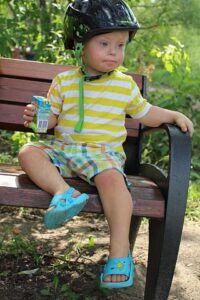
As of 2020, there are approximately more than 70 different known causes of deaf-blindness. The most prevalent of those causes include but are not limited to the following:
- premature birth
- CHARGE syndrome
- Usher syndrome
- Down syndrome
Of all of the known causes of deaf-blindness, roughly 45% of cases appear to be attributed to hereditary disorders and syndromes, 19% continue to have an unknown etiology, and 36% are linked to prenatal congenital, postnatal, and prematurity complications.
COMMUNICATION SKILLS
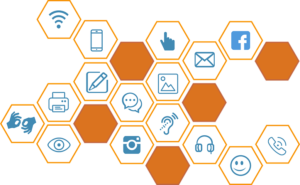
Characteristics
Vision Impairments
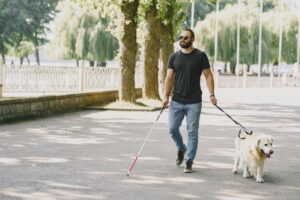
Typically, individuals with deaf-blindness that experience more significant visual impairments than auditory impairments find that auditory communication is the most beneficial method for developing communication skills by receiving and processing auditory information. These individuals generally find the following communication skills to be areas of strength:
- structural language skills, or syntax
- capacity for short-term memory
- vocabulary
Unfortunately, because of the lack of visual input for those individuals that are deaf-blind, these individuals have more trouble in terms of pragmatics, or understanding language. With environmental cues being severely limited for this subgroup of individuals with deaf-blindness, it is exponentially tougher for these individuals to pick up on facial expressions and gestures, and they have difficulty recognizing objects that others refer to since they have trouble actually seeing the items.
Hearing Impairments

Individuals with hearing impairments generally have increased difficulty participating in both expressive and receptive speech. Since the crucial period of language development is dependent on auditory input that takes place when individuals are young, it is clear that a severe lack of auditory input for some individuals with deaf-blindness impedes these individuals’ abilities to develop proper communication skills throughout the rest of their lifetimes. Similar to individuals that experience more visual deficits, those that experience more severe hearing impairments than visual impairments miss out on essential pragmatic cues, such as intonation that highlights important information and silent pauses that indicate turn taking, which significantly impairs these individuals’ abilities to communicate with others.
Interventions
Since the early years of life constitute a critical period for neurological development, early identification of deaf-blindness is vital in ensuring that these individuals attain access to the necessary interventions that will give them a better chance at developing communication skills during this time frame. Without the opportunity to receive these interventions early on, children with deaf-blindness will likely fall behind in their development of language.
One of the most common interventions for individuals with deaf-blindness is the use of a cochlear implant, which is a small electrical device that stimulates the cochlear nerve to improve or restore one’s ability to hear and interpret speech. Since the cochlear implant gives individuals with deaf-blindness the opportunity to take in auditory input that would not have been possible without the device, implantation of the cochlear implant earlier in life proves to be especially important in maximizing individuals’ abilities to develop communication skills appropriately.
In addition to having the cochlear implant installed, individuals with deaf-blindness must also decide on a communication approach that will supplement their language learning. The approaches that one may choose from are:
- A visual, manual-based approach, which includes:
- Physical signs
- sign language
- total communication
- bilingual-bicultural communication
- An auditory-speech based approach

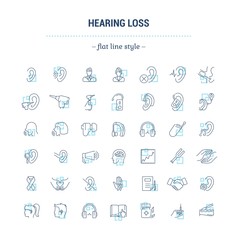
Regardless of which approach an individual with deaf-blindness chooses to take, the greatest communication benefits have been proven to correlate with an earlier age of actually having the cochlear implant implanted.
LITERACY SKILLS

Characteristics
Generally speaking, literacy skills are highly dependent on an array of skills that are typically attained during the early stages of language development. For individuals with deaf-blindness, however, a lack of visual and auditory input hinders the language development process, subsequently causing literacy development to be drastically impaired in most cases.


As a result of this reality, reading and writing frequently seem to be the most severely impaired literacy skills for individuals with deaf-blindness. This stems from the fact that methods of reading that diverge from that of using traditional text end up being much more mentally taxing and harder to learn.
On the other hand, spelling seems to be the least severely impaired literacy skill for those with deaf-blindness. This is because non-traditional methods of teaching spelling still manage to allow individuals to learn their language’s alphabet in a similar time frame to that of traditional teaching methods.
Interventions
Of the various intervention services offered for individuals with deaf-blindness, two of the most commonly-known literacy interventions are the teaching of Braille and the utilization of Augmentative and Alternative Communication.
Background Information About Braille (Video)
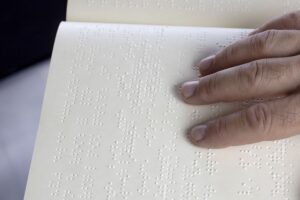
Braille allows individuals with deaf-blindness to feel for specific arrangements of raised dots that represent different letters and numbers. Although it makes literacy development much more accessible for this population, it still requires more dedication and mental energy during the learning process than traditional print alphabets. For people with both extremely impaired hearing and vision, Braille may allow this particular group to access literacy in a way that would otherwise not be possible for these individuals.
Additionally, Augmentative and Alternative Communication (AAC) is defined as any device, system, or method that improves the abilities of a person with a particular communication or literacy impairment. AAC allows instructors and caregivers to adapt resources to the individual’s specific needs, making a variety of resources much more personalized and, as a result, more relatable and beneficial for individuals with deaf-blindness. Some of these resources include daily schedules, story boxes, and interactive journals, which all allow literacy development to be more tangible for individuals with deaf-blindness.
ADDITIONAL RESOURCES
- Causes of Deaf-Blindness
- Deafblind Communication
- Literacy for Children with Combined Vision and Hearing Loss
VIDEO
IMAGE SOURCES
https://www.freepik.com/
https://pixabay.com/
https://www.flaticon.com/
https://www.images.google.com
REFERENCES
Anthony, T. L. (2016). Early Identification of Infants and Toddlers With DeafblindnessDeafblindness. American Annals of the Deaf, 161(4), 412-423. doi:10.1353/aad.2016.0034
Bruce, S., & Bashinski, S. (2016, December 31). Individualizing and Personalizing Communication and Literacy Instruction for Children who are Deafblind [Abstract]. Journal of Deafblind Studies on Communication, 2. http://jdbsc.rug.nl/article/view/25421.
Bruce, S. M., Nelson, C., Perez, A., Stutzman, B., & Barnhill, B. A. (2016, November 5). The State of Research on Communication and Literacy in Deafblindness. Retrieved September 29, 2020, from https://doi.org/10.1353/aad.2016.0035.
Center for Parent Information and Resources. Deaf-Blindness. (2015, June 16). https://www.parentcenterhub.org/deafblindness/.
Cochlear Implant Surgery. (2019). Retrieved October 25, 2020, from https://www.hopkinsmedicine.org/health/treatment-tests-and-therapies/cochlear-implant-surgery
Connor, C., Hieber, S., Arts, A., & Zwolan, T. (2000). Speech, Vocabulary, and the Education of Children Using Cochlear Implants [Abstract]. Journal of Speech, Language, and Hearing Research
Dammeyer, J., & Larsen, F.A. (2016). Communication and language profiles of children with congenital deafblindness. The British Journal of Visual Impairment, 34, 214 – 224.
Dammeyer, J. (2010). Interaction of dual sensory loss, cognitive function, and communication in people who are congenitally deaf-blind. Journal of Visual Impairment And Blindness, 104(11). https://link-gale-com.proxy.library.vanderbilt.edu/apps/doc/A242296065/AONE?u=tel_a_vanderbilt&sid=AONE&xid=e4d27688
Dettman, Shani, Wall, Elizabeth, Constantinescu, Gabriella & Dowell, Richard. (2013). Communication Outcomes for Groups of Children Using Cochlear Implants Enrolled in Auditory-Verbal, Aural-Oral, and Bilingual-Bicultural Early Intervention Programs [Abstract]. Otology & Neurotology, 34, 451-459. https://doi.org/10.1097/MAO.0b013e3182839650etiologies/.hearing-vision-loss/.https://www.nationaldb.org/products/national-child-count/report-2017/
Marschark, M., & Spencer, P. E. (2016). The Fine Art of Conversation. In The Oxford handbook of deaf studies in language (p. 103-110). Oxford: Oxford University Press.
May-Mederake, B. (2012). Early intervention and assessment of speech and language development in young children with cochlear implants [Abstract]. International Journal of Pediatric Otorhinolaryngology, 76(7), 939-946. doi:10.1016/j.ijporl.2012.02.051
National Center on Deaf-Blindness. Causes of Deaf-Blindness. (2020). https://www.nationaldb.org/info-center/overview/causes/.
National Center on Deaf-Blindness. Documented Hearing and Vision Loss. (2017).
National Center on Deaf-Blindness. Etiologies. (2018). https://www.nationaldb.org/products/national-child-count/report-2018/
Nelson, C., & Bruce, S. M. (2019, June 14). Children Who Are Deaf/Hard of Hearing With Disabilities: Paths to Language and Literacy. MDPI. https://www.mdpi.com/2227-7102/9/2/134/htm.
Piper, B., Bulat, J., Kwayumba, D., Oketch, J., & Gangla, L. (2019, September). Measuring Literacy Outcomes for the Blind and for the Deaf: Nationally Representative Results from Kenya. Retrieved September 29, 2020, from https://doi.org/10.1016/j.ijedudev.2019.05.002.
Smelyakov, K., Chupryna, A., Yeremenko, D., Sakhon, A., & Polezhai, V. (2018). Braille Character Recognition Based on Neural Networks. 2018 IEEE Second International Conference on Data Stream Mining & Processing (DSMP). doi:10.1109/dsmp.2018.8478615
Spencer, P., & Marschark, M. (2006). Advances in the spoken language development of deaf and hard-of-hearing children [electronic resource] / edited by Patricia Elizabeth Spencer and Marc Marschark. Oxford University Press.
Stacey, P. C., Fortnum, H. M., Barton, G. R., & Summerfield, A. Q. (2006). Hearing-impaired children in the United Kingdom, I: Auditory performance, communication skills, educational achievements, quality of life, and cochlear implantation. Ear and hearing, 27(2), 161–186. https://doi.org/10.1097/01.aud.0000202353.37567.b4
Tadić, V., Pring, L., & Dale, N. (2009). Are language and social communication intact in children with congenital visual impairment at school age? Journal of Child Psychology and Psychiatry, 51(6), 696–705. https://doi.org/10.1111/j.1469-7610.2009.02200.x
U.S. Department of Education. (2017, May 2). Sec. 300.8 (c) (2). Individuals with Disabilities Education Act. https://sites.ed.gov/idea/regs/b/a/300.8/c/2.
Visvader, P. (2013). AAC Basics and Implementation: How to Teach Students who “Talk with Technology”. Retrieved October 23, 2020, from https://static1.squarespace.com/static/57c86c3cff7c506bc7a8fdbf/t/59f8af6c8165f512162a03b9/1509470066223/AAC+Basics +and+Implementation_+How+to+Teach+Students+who+“Talk+with+Technology”.pdf
What’s Hot in Literacy. (2020). Retrieved September 29, 2020, from https://www.literacyworldwide.org/docs/default-source/resource-documents/whatshotreport_2020_final.pdf.



